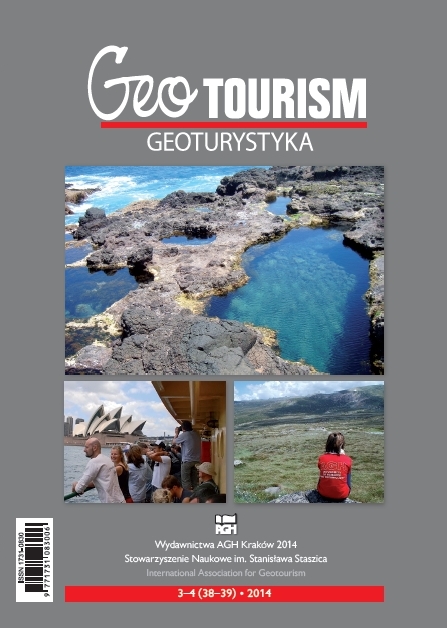Malaysian geotourism – The Langkawi Geopark as a model area
DOI:
https://doi.org/10.7494/geotour.2014.38-39.49Keywords:
geopark, geotourism, Malaysia, Langkawi, sustainable tourism, geotouristic attractionAbstract
The Langkawi Geopark is one of the first geoparks in the region, created under the auspices of UNESCO and can be considered as a role model not only in South East Asia, but also on a global scale. Presently, the approach towards tourism is holistic, therefore, combining the benefits for the environment, local population and tourists (under the idea of sustainable tourism generally and geotourism in particularly) is essential. On the Langkawi Islands, natural conditions for the development of geotourism are outstanding. They exhibit all the major rock types, beginning with those from the Cambrian period, fossil and faults. The most important however, is the fact that all those geological features are well exposed, and they are easy to reach, since the infrastructure on the island is developed excellently. This paper presents the strategy of development of sustainable tourism / geotourism at the governmental level, the geographical settings of Langkawi and geology of Langkawi, infrastructure of Langkawi Geopark and its applied use.Downloads
References
Bignell J.D., Snelling N.J., 1977. Geochronology of Malayan granites. Overseas Geology and Mineral Resources, 47: 1−72.
Che Aziz A., Kamal R.M., Mohd S.L., Ibrahim K., Tanot U., 2008. Field Guide to Geology of Langkawi Geopark, Kuala Lumpur, Malaysia.
Daniel E.G.S., Nadeson T., 2006. WWF-Malaysia and the Malaysian Public Universities towards Action for EfSD. Proceedings of the 2006 ASAIHL Conference on Education for Sustainable Development [EfSD], June 19–22, 2006 Penang, Malaysia.
Jones C.R., 1961. A revision of the stratigraphical sequence of the Langkawi Islands, Federation of Malaya. Proceedings. Ninth Pacific Science Congress, 12: 287−300.
Jones C.R., 1981. Geology and mineral resources of Perlis, North Kedah and the Langkawi Islands. Geological Survey Malaysia District Memoir, 17, 275 pages (includes a detailed geological map of Langkawi).
Lee C.P., 1983. Stratigraphy of the Tarutao and Machinchang formations. In: Nutalaya P. (ed.), Proceedings of Workshop on Stratigraphic Correlation of Thailand and Malaysia. Geological Society of Thailand and Malaysia, Bangkok: 20−38.
Leman M.S., Komoo, I., Mohamed K.R., Ali C.A., Unjah T., 2007. Geopark as an answer to geoheritage conservation in Malaysia – The Langkawi Geopark case study, Institute of Environment and Development, University Kebangsaan, Malaysia.
Leman M.S., Komoo I., Mohamed K.R., Ali C.A., Unjah T., Othman K., Yasin M.H.M., 2008. Geology And Geoheritage Conservation Within Langkawi Geopark, Malaysia, http://www.globalgeopark.org/articles/6337.htm
Marker M.A., Blanco A., Lokanathan S., Verma A., 2008. Ecotourism in Malaysia. In: Clusters and National Competitiveness, Lee Kuan Yew School of Public Policy, Malaysia.
Websites:
www 1 – www3.weforum.org/docs/WEF_TravelTourismCompetitiveness_Report_2007.pdf
www 2 – lkyspp.nus.edu.sg/aci/wpcontent/uploads/sites/4/2013/04/Ecotourism_in_Malaysia_2008_Paper.pdf
www 3 – www.epu.gov.my/en/seventh-malaysia-plan-1996-2000
www 4 – www.epu.gov.my/en/eighth-malaysia-plan-2001-2005
www 5 – www.epu.gov.my/en/ninth-malaysia-plan-2006-2010
www 6 – www.wttc.org
www 7 – www.google.pl/maps
www 8 – www.forestry.gov.my/index.php/en
www 9 – www.lada.gov.my/v2/en/
www 10 – www.statistics.gov.my
www 11 – www.ukm.my/wgm/pdf/preview_buku_Langkawi%20Geopark_geosite.pdf
Downloads
Published
Issue
Section
License

The content of the journal is freely available according to the Creative Commons License Attribution 4.0 International (CC BY 4.0).


